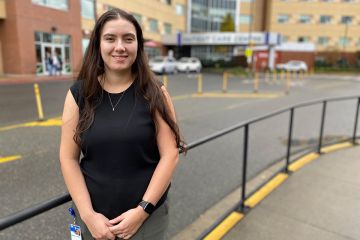Science grad uses machine learning to create Arctic ringed seal detector
- Nicole Crozier

Karlee Zammit’s friends like to say that she’s trying to ‘catch them all’. They’re not referring to Pokémon, however, but to the classic elements—fire, earth, water and air. And they’re not referring to a game of some sort, but to Karlee’s career opportunities.
Zammit will cross the convocation stage this fall to receive her MSc in Marine Bioacoustics and AI, only five years after she crossed the same stage to receive her BSc in Physics. In between the two degrees, she spent time learning about the earth element, working at lodges in New Zealand and as a bear research technician in the Broughton Archipelago. She then moved on to the water element, accepting a position as a project scientist with JASCO Applied Sciences, where she worked on animal movement modelling to produce statistics about sound level exposure of multiple marine species. After a few years at JASCO, she started thinking about a master’s degree.
“I started to feel that I was ready for a change, although I wasn’t exactly sure where to start,” says Zammit. “A lot of interesting positions I saw required a master’s degree, so I reached out to former professors who studied interesting topics about potential programs.”
Her outreach landed her back at UVic, and Zammit’s exploration of the water element continued in her master’s program. Her research, supervised by Stan Dosso and William Halliday, centred on the Arctic ringed seal, the most abundant seal species in the Arctic. Using machine learning, and in partnership with the Wildlife Conservation Society Canada, Zammit created a ringed seal detector that can take a large dataset of ocean noise and identify ringed seal vocalizations.
“Coming into my master’s degree, I didn’t really know anything about deep learning,” says Zammit. “I took a class, and then was able to implement what I learned with help from some awesome advisors. The detector we created can successfully detect all the ringed seals in the dataset. It still gets confused by ice and water noise sometimes, and we need more data to make it better, but it works.”

Zammit’s ringed seal detector will be used by her research group to monitor the impact of Arctic noise on the ringed seal population, which has been identified as a species of concern. As climate change alters the Arctic environment, longer ice-free seasons will likely lead to an increase in shipping traffic, which could cause problems for group communication, navigation and finding food.
While Zammit’s research project didn’t require a trip to the Arctic, she did have the opportunity to spend two weeks in Ulukhaktok trying to catch ringed seals as part of a separate research trip. Every day, they would wake up, go out on a power boat and try to catch the seals in nets. While they were unsuccessful in catching any seals, they did collect acoustic data that could be used with the detector she was developing.
Zammit may just be graduating this fall, but she’s already moved on to her next thing—and her next element, fire. She is currently working for the Government of BC as a fire research scientist, where she is using satellite data to try to figure out how to improve fire detection algorithms. While satellites can tell where a fire is based on reflected radiances (different wavelengths of light), current algorithms result in some false positives. Zammit is trying to create an algorithm that will remove the false positives.
Zammit didn’t land her current job through a typical application process. She took advantage of the time her master’s gave her to think about her career, and cold emailed different people to learn about different opportunities. One of these people was a fire scientist in the government, who told her what government was like and what other fire research opportunities might be like in Canada. Through that conversation, she got hired as a machine learning researcher with local company FireAI, and ultimately got offered her current position.
“Most scientists in the fire world come from an ecological background, but I have found that having a physics background has allowed me to work in a variety of different fields,” says Zammit. “Deep learning is huge at the moment, and having some experience in that area, through my master’s, has definitely helped me be more hireable.”
Zammit isn’t sure where her career will end up down the line, but she is excited to jump into fire and see where it takes her. She dreams of being able to balance her other passions, like whale watching and driving water taxis, with science. Ideally, she’s interested in roles with lots of variety, where she is helping the planet, positively impacting conservation or mitigating the impacts of climate change.
Maybe one of her future roles will be focused on air, and finally allow her to catch them all.
Photos
In this story
Keywords: convocation, student life, science, research, arctic, oceans, community
People: Karlee Zammit







